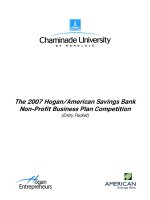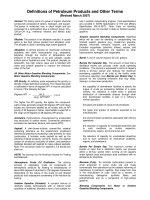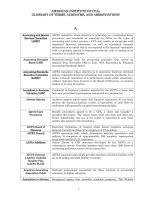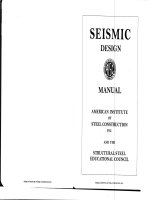Api publ 4629 2007 (american petroleum institute)
Bạn đang xem bản rút gọn của tài liệu. Xem và tải ngay bản đầy đủ của tài liệu tại đây (118.77 KB, 22 trang )
Hexavalent Chromium Exposures
During Hot Work
--`,``,````,,````,``,`,,,,``,`,-`-`,,`,,`,`,,`---
API PUBLICATION 4629
SECOND EDITION, JUNE 2007
Copyright American Petroleum Institute
Provided by IHS under license with API
No reproduction or networking permitted without license from IHS
Licensee=IHS Employees/1111111001, User=Wing, Bernie
Not for Resale, 08/07/2007 01:11:44 MDT
--`,``,````,,````,``,`,,,,``,`,-`-`,,`,,`,`,,`---
Copyright American Petroleum Institute
Provided by IHS under license with API
No reproduction or networking permitted without license from IHS
Licensee=IHS Employees/1111111001, User=Wing, Bernie
Not for Resale, 08/07/2007 01:11:44 MDT
Hexavalent Chromium Exposures
During Hot Work
Regulatory Analysis and Scientific Affairs Department
API PUBLICATION 4629
SECOND EDITION, JUNE 2007
WRITTEN BY
Jenny Crittell, CIH
EDITED BY
API Industrial Hygiene Task Force
SAMPLING CONDUCTED BY
Sid Hebert, CIH, CSP of ICU Environmental Health & Safety
Conoco Phillips, Inc.
--`,``,````,,````,``,`,,,,``,`,-`-`,,`,,`,`,,`---
Copyright American Petroleum Institute
Provided by IHS under license with API
No reproduction or networking permitted without license from IHS
Licensee=IHS Employees/1111111001, User=Wing, Bernie
Not for Resale, 08/07/2007 01:11:44 MDT
SPECIAL NOTES
API publications necessarily address problems of a general nature. With respect to particular
circumstances, local, state, and federal laws and regulations should be reviewed.
Neither API nor any of API’s employees, subcontractors, consultants, committees, or other
assignees make any warranty or representation, either express or implied, with respect to the
accuracy, completeness, or usefulness of the information contained herein, or assume any
liability or responsibility for any use, or the results of such use, of any information or process
disclosed in this publication. Neither API nor any of API’s employees, subcontractors,
consultants, or other assignees represent that use of this publication would not infringe upon
privately owned rights.
API publications may be used by anyone desiring to do so. Every effort has been made by the
Institute to assure the accuracy and reliability of the data contained in them; however, the
Institute makes no representation, warranty, or guarantee in connection with this publication and
hereby expressly disclaims any liability or responsibility for loss or damage resulting from its use
or for the violation of any authorities having jurisdiction with which this publication may conflict.
API publications are published to facilitate the broad availability of proven, sound engineering
and operating practices. These publications are not intended to obviate the need for applying
sound engineering judgment regarding when and where these publications should be utilized.
The formulation and publication of API publications is not intended in any way to inhibit anyone
from using any other practices.
--`,``,````,,````,``,`,,,,``,`,-`-`,,`,,`,`,,`---
Any manufacturer marking equipment or materials in conformance with the marking
requirements of an API standard is solely responsible for complying with all the applicable
requirements of that standard. API does not represent, warrant, or guarantee that such products
do in fact conform to the applicable API standard.
All rights reserved. No part of this work may be reproduced, stored in a retrieval system, or
transmitted by any means, electronic, mechanical, photocopying, recording, or otherwise, without
prior written permission from the publisher. Contact the Publisher, API Publishing Services, 1220
L Street, N.W., Washington, D.C. 20005.
Copyright © 2007 American Petroleum Institute
Copyright American Petroleum Institute
Provided by IHS under license with API
No reproduction or networking permitted without license from IHS
Licensee=IHS Employees/1111111001, User=Wing, Bernie
Not for Resale, 08/07/2007 01:11:44 MDT
--`,``,````,,````,``,`,,,,``,`,-`-`,,`,,`,`,,`---
API FOREWORD
Nothing contained in any API publication is to be construed as granting any right, by implication
or otherwise, for the manufacture, sale, or use of any method, apparatus, or product covered by
letters patent. Neither should anything contained in the publication be construed as insuring
anyone against liability for infringement of letters patent.
Suggested revisions are invited and should be submitted to the Director of Regulatory Analysis
and Scientific Affairs, API, 1220 L Street, NW, Washington, DC 20005.
Copyright American Petroleum Institute
Provided by IHS under license with API
No reproduction or networking permitted without license from IHS
Licensee=IHS Employees/1111111001, User=Wing, Bernie
Not for Resale, 08/07/2007 01:11:44 MDT
--`,``,````,,````,``,`,,,,``,`,-`-`,,`,,`,`,,`---
Copyright American Petroleum Institute
Provided by IHS under license with API
No reproduction or networking permitted without license from IHS
Licensee=IHS Employees/1111111001, User=Wing, Bernie
Not for Resale, 08/07/2007 01:11:44 MDT
TABLE OF CONTENTS
Executive Summary ...................................................................................................................... 1
Methodology .................................................................................................................................. 2
Discussion....................................................................................................................................... 3
Carbon Arc Cutting (CAC)......................................................................................................... 3
Flux Cored Arc Welding (FCAW) ............................................................................................. 4
Gas Metal Arc Welding (GMAW or MIG) ................................................................................ 5
Grinding ...................................................................................................................................... 6
Gas Tungsten Arc Welding (GTAW) ......................................................................................... 8
Oxyfuel Cutting (OFC) ............................................................................................................... 9
Shielded Metal Arc Welding (SMAW or stick welding).......................................................... 10
Conclusions.................................................................................................................................. 12
References.................................................................................................................................... 12
List of Figures
--`,``,````,,````,``,`,,,,``,`,-`-`,,`,,`,`,,`---
Figure 1: Overview by Type of Hot Work.................................................................................. 1
Figure 2: Overview by Base Metal .............................................................................................. 2
Figure 3: CAC Results Distribution............................................................................................ 4
Figure 4: FCAW Results Distribution ........................................................................................ 5
Figure 5: GMAW Results Distribution....................................................................................... 6
Figure 6: Grinding Results Distribution..................................................................................... 7
Figure 7: GTAW Results Distribution........................................................................................ 9
Figure 8: OFC Results Distribution .......................................................................................... 10
Figure 9: SMAW Results Distribution...................................................................................... 11
List of Tables
Table 1: CAC Results Summary ................................................................................................. 3
Table 2: FCAW Results Summary.............................................................................................. 4
Table 3: GMAW Results Summary ............................................................................................ 5
Table 4: Grinding Results Summary .......................................................................................... 7
Table 5: GTAW Results Summary ............................................................................................. 8
Table 6: OFC Results Summary.................................................................................................. 9
Table 7: SMAW Results Summary ........................................................................................... 11
Copyright American Petroleum Institute
Provided by IHS under license with API
No reproduction or networking permitted without license from IHS
Licensee=IHS Employees/1111111001, User=Wing, Bernie
Not for Resale, 08/07/2007 01:11:44 MDT
--`,``,````,,````,``,`,,,,``,`,-`-`,,`,,`,`,,`---
Copyright American Petroleum Institute
Provided by IHS under license with API
No reproduction or networking permitted without license from IHS
Licensee=IHS Employees/1111111001, User=Wing, Bernie
Not for Resale, 08/07/2007 01:11:44 MDT
Hexavalent Chromium Exposures During Hot Work
Executive Summary
--`,``,````,,````,``,`,,,,``,`,-`-`,,`,,`,`,,`---
This report details the findings from an air sampling survey contracted by the American Petroleum
Institute (API) to evaluate inhalation exposures to hexavalent chromium (chromium (VI)) during seven
types of hot work: carbon arc cutting (CAC), flux cored arc welding (FCAW), gas metal arc welding
(GMAW or MIG), grinding, gas tungsten arc welding (GTAW or TIG), oxyfuel gas cutting (OFC or
torch cutting), and shielded metal arc welding (SMAW or stick). Eighty-three samples were collected in
October and November 2005 at two petroleum sites during maintenance turnarounds by API member
companies. An additional 188 samples were collected April – June 2006 at three different petroleum
company sites by ICU Environmental Health and Safety. Of the 271 total samples, 63 samples were at
or above the Occupational Safety and Health Administration (OSHA) action level of 2.5 ug/m3 and 51
were at or above the OSHA permissible exposure limit of 5 ug/m3.
The following two figures show an overview of the results. The first figure shows the number of
samples collected for each type of hot work and the number of those samples that exceeded the OSHA
permissible exposure limit and/or action level.
Figure 1: Overview by Type of Hot Work
120
108
100
77
80
Total Number of Samples
60
Number > Action Level
39
40
Number > PEL
27
1515
20
6 5 4
9
2 1
7 5
17
13
17
5
13
00
0
CAC
FCAW GMAW Grinding GTAW OFC
SMAW
(TIG) (Torch (Stick)
(MIG)
Cutting)
The second figure shows the distribution of samples exceeding the exposure limit and/or action level
grouped according to the base metal involved during the sample collection.
1
Users of this information should not rely exclusively on the information contained in this document. Sound business, scientific, engineering,
and safety judgment should be used in employing the information contained herein.
Copyright American Petroleum Institute
Provided by IHS under license with API
No reproduction or networking permitted without license from IHS
Licensee=IHS Employees/1111111001, User=Wing, Bernie
Not for Resale, 08/07/2007 01:11:44 MDT
2
API PUBLICATION 4629
Figure 2: Overview by Base Metal
90
80
80
70
66
60
54
49
50
39
40
34
Total Number of Samples
Number > PEL
Number > Action Level
30
22
20
10
2 3
6
9
9
12
0 0
0
Carbon Steel Chrome Steel Galvanized
Steel
Inconel
Stainless
Steel
From the two figures, it is apparent that both the type of hot work and the type of base metal must be
considered together in order to draw conclusions on expected airborne concentrations. As discussed in
the report, sample results were grouped based on type of hot work and base metal. In some cases, it was
also important to look at the environmental conditions and the welding electrode as well. The intent of
this survey is to provide sampling data that can be used as objective data to characterize employee
exposure to chromium (VI) in accordance with the requirements of 29 CFR 1910.1026.
Methodology
--`,``,````,,````,``,`,,,,``,`,-`-`,,`,,`,`,,`---
Samples were collected and analyzed in accordance with the National Institute of Occupational Safety
and Health (NIOSH) Method 7605. All activities were sampled by drawing known volumes of air
through 37-mm polystyrene cassettes containing PVC filters. Prior to sampling, personal air sampling
pumps were calibrated to +/- 5% of the recommended flow rate of 1.0 liter/minute with the
representative sampler in line. Flow rates were verified after sampling. The air sampling pump was
placed on the worker’s belt and the sampling cassette was placed in the breathing zone outside the
welding helmet. The majority of the samples were TWA samples, collected for the majority of the shift
(8- 10- and 12-hour shifts were monitored). Twelve of the samples are considered task samples (sample
time was less than five hours). After sampling, the samples and field blanks were kept refrigerated until
shipped overnight to the Conoco Phillips Laboratory in Bartlesville, Oklahoma for analysis. The Conoco
Phillips laboratory is accredited by the American Industrial Hygiene Association. The samples were
analyzed by ion chromatography with UV detection. Results were calculated as a time-weighted average
over the total sample time. Adjustment to a specific shift length was not made.
Users of this information should not rely exclusively on the information contained in this document. Sound business, scientific, engineering,
and safety judgment should be used in employing the information contained herein.
Copyright American Petroleum Institute
Provided by IHS under license with API
No reproduction or networking permitted without license from IHS
Licensee=IHS Employees/1111111001, User=Wing, Bernie
Not for Resale, 08/07/2007 01:11:44 MDT
HEXAVALENT CHROMIUM EXPOSURES DURING HOT WORK
3
Samples were collected at five different sites over a period of five months. Samples were collected at
three of the sites during maintenance turnaround activities, and during new construction at the remaining
two.
Discussion
The main health effects of workplace exposure to chromium (VI) are lung cancer, asthma, bronchitis,
and damage to nasal epithelia, skin, and eyes. Chromium (VI) can be produced during welding
operations even if the chromium was originally present in another valence state. Welders/cutters were
the primary job tasks sampled, along with some fitters and helpers.
During the sampling, notes and observations were recorded concerning the task monitored
(welder/cutter, fitter, helper, etc.), the work process (hot work process, base metal, and filler/electrode),
the work environment (inside vessel, temporary fab tent, wide open area, spark enclosure, etc.), the
vessel type (if applicable), the ventilation type, respiratory protection, and sample identification
information (sample number, date sample collected, worker name, ID, employer). This information,
along with the monitoring results, monitoring time, analytical method, and type of sample, was loaded
into a Microsoft Access database. The data allows for a variety of combinations for analyzing and
interpreting the data. In order to provide information that is both statistically significant as well as being
practically relevant, the two main parameters used to compare the data in this report are the type of hot
work and base metal. Select data fields have been attached to this report as an Excel spreadsheet.
Carbon Arc Cutting (CAC)
Only six samples were collected during CAC, and all samples were collected on welders/cutters working
inside a vessel. Results generally indicate the potential for concentrations to exceed the exposure limit
regardless of the base metal. Due to the small sample set, specific conclusions cannot be made about this
particular type of hot work. Results are summarized in Table 1:
Table 1: CAC Results Summary
Base Metals
All
Chrome steel
All Chrome steels
• Chrome 9%
Galvanized steel
Inconel
All Stainless Steels
• SS 17–19% Cr
• SS >19% Cr
Total #
Samples
#>
PEL
Minimum
(ug/m3)
6
0
3
3
0
0
3
1
2
4
0
2
2
0
0
2
1
1
1.97
0
1.97
1.97
0
0
2.95
56.599
2.95
Maximum Geometric Arithmetic
(ug/m3)
mean
mean
56.599
0
9.652
9.652
0
0
56.599
56.599
8.89
7.979
0
5.581
5.581
0
0
11.407
56.599
5.121
14.867
0
6.921
6.921
0
0
22.813
56.599
5.920
Users of this information should not rely exclusively on the information contained in this document. Sound business, scientific, engineering,
and safety judgment should be used in employing the information contained herein.
--`,``,````,,````,``,`,,,,``,`,-`-`,,`,,`,`,,`---
Copyright American Petroleum Institute
Provided by IHS under license with API
No reproduction or networking permitted without license from IHS
Licensee=IHS Employees/1111111001, User=Wing, Bernie
Not for Resale, 08/07/2007 01:11:44 MDT
4
API PUBLICATION 4629
Figure 3: CAC Results Distribution
3
125 to
<250
50 to
<125
5 to <50
--`,``,````,,````,``,`,,,,``,`,-`-`,,`,,`,`,,`---
2.5 to <5
0
0.5 to
<2.5
<0.5
0
0
0
0
>/= 5000
1
500 to
<5000
1
250 to
<500
1
ug/m3
Flux Cored Arc Welding (FCAW)
Nine samples were collected during FCAW, all when welding on S200-304; 316-321; 330-347; 43
stainless steel (containing 17-19% chromium). The one sample that exceeded the exposure limit was the
only sample that was collected during welding inside a vessel. The remaining eight samples were
collected outside the vessel or in open air. The result for this one sample was over 15 times greater than
the next highest sample result. Although results indicate that exposures to chromium (VI) will be below
the PEL during FCAW operations on stainless steel outside a confined space, based on the statistical
calculations, concentrations in excess of the PEL are still likely to occur.
Table 2: FCAW Results Summary
Base Metals
All
Carbon steel
All Chrome steels
Galvanized steel
Inconel
All Stainless steels
• SS 17–19% Cr
Total #
#>
Samples PEL
9
0
0
0
0
9
9
1
0
0
0
0
1
1
Minimum
(ug/m3)
0.016
0
0
0
0
0.016
0.016
Maximum Geometric Arithmetic
(ug/m3)
mean
mean
40.869
0
0
0
0
40.869
40.869
0.575
0
0
0
0
0.575
0.575
5.486
0
0
0
0
5.486
5.486
Users of this information should not rely exclusively on the information contained in this document. Sound business, scientific, engineering,
and safety judgment should be used in employing the information contained herein.
Copyright American Petroleum Institute
Provided by IHS under license with API
No reproduction or networking permitted without license from IHS
Licensee=IHS Employees/1111111001, User=Wing, Bernie
Not for Resale, 08/07/2007 01:11:44 MDT
HEXAVALENT CHROMIUM EXPOSURES DURING HOT WORK
5
Figure 4: FCAW Results Distribution
4
>/= 5000
500 to
<5000
250 to
<500
5 to <50
125 to
<250
1
50 to
<125
1
2.5 to <5
0.5 to
<2.5
--`,``,````,,````,``,`,,,,``,`,-`-`,,`,,`,`,,`---
<0.5
3
ug/m3
Gas Metal Arc Welding (GMAW or MIG)
Twenty-seven samples were collected during GMAW (MIG welding) tasks and fifteen of the samples
exceeded the exposure limit. All fifteen of these samples were collected when installing a 309 stainless
steel welded overlay on a carbon steel vessel using ER309L electrode. This electrode contains 23%
chromium. All were collected at the same job site and mechanical ventilation was in use during each
task. Fourteen of the fifteen samples were collected during welding tasks inside a vessel; the exception
was collected inside a spark enclosure. Sample results indicate that the PEL is likely to be exceeded
during operations on stainless steel inside a vessel.
Nine samples were collected during MIG welding on Inconel using Inconel 617 wire. All nine samples
were collected during welding inside a vessel, and seven of these welders were using local exhaust
ventilation during the sampling. The other two welders used only natural ventilation. Despite the 16%
chromium content in Inconel alloy, these results indicate that exposures are not likely to exceed the PEL.
Table 3: GMAW Results Summary
Base Metals
Total #
Samples
#>
PEL
Minimum
(ug/m3)
All
Carbon steel
All Chrome steels
Galvanized steel
Inconel
All Stainless steels
• SS >19 Cr
• Stainless (unspecified)
27
0
0
0
9
18
15
3
15
0
0
0
0
15
15
0
0.009
0
0
0
0.009
0.012
8.44
0.012
Maximum Geometric Arithmetic
(ug/m3)
mean
mean
51.91
0
0
0
0.066
51.91
51.91
0.15
0.907
0
0
0
0.013
7.689
20.599
0.056
13.004
0
0
0
0.017
19.498
23.381
0.086
Users of this information should not rely exclusively on the information contained in this document. Sound business, scientific, engineering,
and safety judgment should be used in employing the information contained herein.
Copyright American Petroleum Institute
Provided by IHS under license with API
No reproduction or networking permitted without license from IHS
Licensee=IHS Employees/1111111001, User=Wing, Bernie
Not for Resale, 08/07/2007 01:11:44 MDT
6
API PUBLICATION 4629
Figure 5: GMAW Results Distribution
14
12
0
0
0
0
125 to
<250
250 to
<500
500 to
<5000
>/= 5000
50 to <125
2.5 to <5
5 to <50
0
0.5 to <2.5
<0.5
1
0
ug/m3
Grinding
A total of 39 samples were collected during grinding operations and five of the samples exceeded the
PEL. All five of these samples were collected during grinding inside a vessel while one or more welders
were welding in the same vessel and mechanical ventilation was in use. The highest sample result
(56.626 ug/m3) occurred when there were four welders inside the drum while the sampling took place.
Four of the samples were collected during grinding inside a coke drum on SS410 (contains 11-13%
chromium) and Inconel rod. The fifth sample was collected while grinding inside a vessel above a
welder who was gouging. The air was flowing from the bottom to the top of the vessel, across the
breathing zone of the individual being sampled. Based on these observations, these sample results were
most likely elevated due to the interference from the other operations taking place in the immediate area.
Ten other samples collected when grinding on stainless steel were below the PEL.
--`,``,````,,````,``,`,,,,``,`,-`-`,,`,,`,`,,`---
Fourteen samples were collected when grinding on carbon steel and all samples were below the PEL.
All seven samples collected when grinding on chrome steel were also below the PEL. Based on the
results of this sampling, tasks involving grinding on carbon steel and chrome steel are unlikely to
produce concentrations above the PEL.
Users of this information should not rely exclusively on the information contained in this document. Sound business, scientific, engineering,
and safety judgment should be used in employing the information contained herein.
Copyright American Petroleum Institute
Provided by IHS under license with API
No reproduction or networking permitted without license from IHS
Licensee=IHS Employees/1111111001, User=Wing, Bernie
Not for Resale, 08/07/2007 01:11:44 MDT
HEXAVALENT CHROMIUM EXPOSURES DURING HOT WORK
7
Table 4: Grinding Results Summary
Total #
#>
Samples PEL
39
14
7
2
2
3
1
2
15
6
8
1
All
Carbon steel
All Chrome steels
• Chrome <2.5%
• Chrome 5%
• Chrome 9%
Galvanized steel
Inconel
All Stainless steels
• SS 11-13% Cr
• SS 17–19% Cr
• Stainless (unspecified)
5
0
0
0
0
0
0
0
5
4
1
0
Minimum
(ug/m3)
Maximum Geometric Arithmetic
(ug/m3)
mean
mean
0.005
0.005
0.015
0.019
0.015
0.018
0.034
0.0097
0.0088
2.233
0.0104
0.0088
56.626
0.297
0.16
0.132
0.16
0.139
0.034
0.012
56.626
56.626
14.906
0.0088
0.116
0.031
0.053
0.050
0.049
0.057
0.034
0.011
0.842
12.421
0.198
0.0088
3.786
0.058
0.080
0.076
0.088
0.077
0.034
0.011
9.748
20.788
2.686
0.0088
Figure 6: Grinding Results Distribution
30
0
0
0
0
250 to
<500
500 to
<5000
>/= 5000
50 to <125
1
5 to <50
2.5 to <5
0.5 to <2.5
<0.5
2
125 to
<250
4
2
ug/m3
Users of this information should not rely exclusively on the information contained in this document. Sound business, scientific, engineering,
and safety judgment should be used in employing the information contained herein.
Copyright American Petroleum Institute
Provided by IHS under license with API
No reproduction or networking permitted without license from IHS
Licensee=IHS Employees/1111111001, User=Wing, Bernie
Not for Resale, 08/07/2007 01:11:44 MDT
--`,``,````,,````,``,`,,,,``,`,-`-`,,`,,`,`,,`---
Base Metals
8
API PUBLICATION 4629
Gas Tungsten Arc Welding (GTAW or TIG)
Of the 77 samples collected during GTAW (TIG welding), only 13 exceeded the exposure limit. Nine of
the 38 samples collected when welding on Inconel exceeded the exposure limit. All nine samples were
collected during welding operations inside a vessel using Inconel rod 117 and used mechanical
ventilation. Twelve additional samples collected inside a vessel were below the exposure limit. These
twelve welders were using either Inconel rod 117 or 617, and those who used rod 117 had higher results.
These results indicate there is a potential for concentrations to exceed the exposure limit when welding
on Inconel inside a vessel.
Only five samples were collected during TIG welding on carbon steel and one exceeded the exposure
limit. This welder was TIG welding using electrode ER7018, and he was also gouging and grinding. All
five samples were collected during welding operations outside. Due to the small sample set, specific
conclusions cannot be made about TIG welding on carbon steel.
Sixteen samples were collected during TIG welding on chrome steels, and two exceeded the exposure
limit. Both were collected during welding on 5% chrome steel inside a fab tent. Both of these samples
were collected during grinding and welding on a 5% chrome pipe run to a 9% chrome 90o joint. Both
welders were using electrode 8018 during the sampling. Three additional samples were also collected
during operations inside a fab tent, but were below the exposure limit. The remaining eleven samples
were collected inside a vessel (4 samples) and outside (7 samples), and results were below the PEL.
Of the eighteen samples collected when the base metal was some type of stainless steel, only one
exceeded the exposure limit. This was the only sample collected on stainless steel 400-420 (containing
11–13% chromium). During this sampling, the welder was using an Inconel rod and grinding the welds
in between welding. This sample was collected during welding tasks inside a vessel. Sample results
indicate that concentrations above the exposure limit are unlikely to occur during welding other stainless
steels. Ten other samples were collected inside a vessel, and were below the PEL. The remaining seven
samples were collected inside a temporary fab tent (3 samples), and in a shop (4 samples).
Table 5: GTAW Results Summary
All
Carbon steel
All Chrome steels
• Chrome <2.5%
• Chrome 5%
• Chrome 9%
• Chrome 12%
Galvanized steel
Inconel
All Stainless steels
• SS 11–13% Cr
• SS 17–19% Cr
• Stainless (unspecified)
Total #
#>
Samples PEL
77
5
16
4
5
4
3
0
38
18
1
13
4
13
1
2
0
2
0
0
0
9
1
1
0
0
Minimum
(ug/m3)
0.008
0.017
0.017
0.055
0.031
0.017
0.38
0
0.008
0.01
5.638
0.017
0.01
Maximum Geometric Arithmetic
(ug/m3)
mean
mean
33.146
5.982
11.7
0.122
11.7
0.643
2.28
0
33.146
5.638
5.638
0.83
0.14
0.182
0.069
0.288
0.092
1.448
0.053
0.850
0
0.241
0.088
5.638
0.081
0.040
2.726
1.216
1.692
0.0963
4.520
0.179
1.123
0
4.423
0.481
5.638
0.213
0.059
Users of this information should not rely exclusively on the information contained in this document. Sound business, scientific, engineering,
and safety judgment should be used in employing the information contained herein.
Copyright American Petroleum Institute
Provided by IHS under license with API
No reproduction or networking permitted without license from IHS
Licensee=IHS Employees/1111111001, User=Wing, Bernie
Not for Resale, 08/07/2007 01:11:44 MDT
--`,``,````,,````,``,`,,,,``,`,-`-`,,`,,`,`,,`---
Base Metals
HEXAVALENT CHROMIUM EXPOSURES DURING HOT WORK
9
Figure 7: GTAW Results Distribution
53
13
0
0
0
250 to
<500
500 to
<5000
>/= 5000
0
125 to
<250
5 to <50
0
50 to <125
4
2.5 to <5
0.5 to <2.5
<0.5
7
ug/m3
Oxyfuel Cutting (OFC)
Only five samples were collected during OFC (torch cutting). Results generally indicate that exposures
are below the exposure limit. Due to the small sample set, specific conclusions cannot be made about
this particular type of hot work. Results for these samples are summarized in Table 6:
--`,``,````,,````,``,`,,,,``,`,-`-`,,`,,`,`,,`---
Table 6: OFC Results Summary
Base Metals
All
Carbon steel
All Chrome steels
Galvanized steel
Inconel
All Stainless steels
• SS 11-13% Cr
Total #
#>
Samples PEL
5
3
0
1
0
1
1
0
0
0
0
0
0
0
Minimum
(ug/m3)
0.015
0.015
0
1.125
0
0.689
0.689
Maximum Geometric Arithmetic
(ug/m3)
mean
mean
1.125
0.099
0
1.125
0
0.689
0.689
0.121
0.032
0
1.125
0
0.689
0.689
0.390
0.046
0
1.125
0
0.689
0.689
Users of this information should not rely exclusively on the information contained in this document. Sound business, scientific, engineering,
and safety judgment should be used in employing the information contained herein.
Copyright American Petroleum Institute
Provided by IHS under license with API
No reproduction or networking permitted without license from IHS
Licensee=IHS Employees/1111111001, User=Wing, Bernie
Not for Resale, 08/07/2007 01:11:44 MDT
10
API PUBLICATION 4629
Figure 8: OFC Results Distribution
3
0
0
0
0
250 to
<500
500 to
<5000
>/= 5000
5 to <50
0
125 to
<250
0
50 to <125
0
2.5 to <5
0.5 to <2.5
<0.5
2
ug/m3
Shielded Metal Arc Welding (SMAW or stick welding)
Only 13 of the 108 samples collected during SMAW (stick welding) exceeded the permissible exposure
limit. During welding on carbon steel, only one of 44 samples exceeded the exposure limit and results
indicate that exposures above the exposure limit are unlikely to occur. The one sample that exceeded the
exposure limit was collected on a welder working inside a vessel, using electrode ENICROM-4. This
was the only sample collected using this particular electrode. Fourteen additional samples were collected
during stick welding on carbon steel while inside a vessel that were below the exposure limit.
During stick welding on chrome steels, results generally indicate that concentrations will not exceed the
exposure limit. Two of the 28 samples exceeded the PEL. The one sample collected during welding on
5% chrome steel that exceeded the exposure limit was collected inside a vessel, using electrode E8018.
Two others that were also collected inside a vessel using this electrode were below the exposure limit.
The one sample collected on 9% chrome steel that exceeded the exposure limit was collected on an
individual working inside a spark enclosure. The individual was also TIG welding and grinding during
the monitoring period, which may have contributed to the concentration measured. Five other samples
collected inside a spark enclosure were below the exposure limit.
Results for stick welding on galvanized steel indicate that concentrations are not likely to exceed the
exposure limit. Only one of the samples was collected inside a vessel. All twenty of the samples results
were below the PEL.
Ten of the sixteen samples collected during welding on stainless steels exceeded the PEL. All of the
samples were collected during welding inside a vessel. These results indicate that concentrations in
excess of the exposure limit are likely to occur.
Users of this information should not rely exclusively on the information contained in this document. Sound business, scientific, engineering,
and safety judgment should be used in employing the information contained herein.
--`,``,````,,````,``,`,,,,``,`,-`-`,,`,,`,`,,`---
Copyright American Petroleum Institute
Provided by IHS under license with API
No reproduction or networking permitted without license from IHS
Licensee=IHS Employees/1111111001, User=Wing, Bernie
Not for Resale, 08/07/2007 01:11:44 MDT
HEXAVALENT CHROMIUM EXPOSURES DURING HOT WORK
11
Table 7: SMAW Results Summary
--`,``,````,,````,``,`,,,,``,`,-`-`,,`,,`,`,,`---
Base Metals
Total #
#>
Samples PEL
All
Carbon steel
All Chrome steels
• Chrome <2.5%
• Chrome 5%
• Chrome 9%
Galvanized steel
Inconel
All Stainless steels
• SS 11–13% Cr
• SS 17–19% Cr
• SS >19% Cr
• Stainless (unspecified)
108
44
28
5
11
12
20
0
16
11
1
1
3
13
1
2
0
1
1
0
0
10
10
0
0
0
Minimum
(ug/m3)
Maximum Geometric Arithmetic
(ug/m3)
mean
mean
0.008
0.008
0.018
0.018
0.133
0.018
0.017
0
0.023
4.114
0.023
0.077
0.17
79.878
16.1
23.2
0.15
8.0
23.2
0.84
0
79.878
79.878
0.023
0.077
1.0
0.301
0.168
0.295
0.035
0.729
0.314
0.141
0
4.002
17.549
0.023
0.077
0.371
3.371
0.709
1.741
0.051
1.668
2.511
0.266
0
17.423
25.199
0.023
0.077
0.490
Figure 9: SMAW Results Distribution
72
19
1
0
0
0
0
125 to
<250
250 to
<500
500 to
<5000
>/= 5000
5 to <50
2.5 to <5
0.5 to <2.5
<0.5
4
50 to <125
12
ug/m3
Users of this information should not rely exclusively on the information contained in this document. Sound business, scientific, engineering,
and safety judgment should be used in employing the information contained herein.
Copyright American Petroleum Institute
Provided by IHS under license with API
No reproduction or networking permitted without license from IHS
Licensee=IHS Employees/1111111001, User=Wing, Bernie
Not for Resale, 08/07/2007 01:11:44 MDT
12
API PUBLICATION 4629
Conclusions
Based on the results of this survey, some general observations can be made concerning personal
exposures to hexavalent chromium based on the type of hot work in conjunction with the base metal. A
statistical analysis of the sample results collected during this survey was completed to determine the
exceedance fraction or probability of non-compliance. The one-sided 95% upper confidence limit (UCL1,95%) of the exceedance fraction was calculated. If the value of the UCL1,95% was 20%, we are 95%
confident that 20% or less of the exposure profile is above the PEL or Action Level. These conclusions
are affected by the number of samples in the sample set, and the statistical calculations are more
accurate as the number of samples increases. Calculations were not performed for sample sets of less
than six samples.
The following operations had a calculated UCL1,95% of 20% or more and are considered likely to
produce concentrations in excess of the OSHA PEL for chromium (VI):
•
FCAW on stainless steel outside
•
GMAW on stainless steel inside a vessel
•
GTAW on Inconel inside a vessel
•
SMAW on stainless steel inside a vessel
The following operations had a calculated UCL1,95% or 20% or more and are considered likely to
produce concentrations in excess of the OSHA Action Level but below the PEL for chromium (VI):
•
SMAW on chrome steel outside
The following operations had a calculated UCL1,95% of less than 20% and are not likely to produce
concentrations above the OSHA PEL or Action Level for chromium (VI):
•
GMAW on Inconel inside a vessel
•
Grinding on carbon steel outside
•
GTAW on chrome steels outside
•
GTAW on stainless steel inside a vessel
•
SMAW on carbon steel regardless of environmental conditions
•
SMAW on galvanized steel outside
References
1. Mulhausen, John R., Ph.D., CIH and Joseph Damiano, MS, CIH, CSP: A Strategy for
Assessing and Managing Occupational Exposures. Fairfax, VA: American Industrial Hygiene
Association, 1998.
2. National Institute for Occupational Safety and Health: Criteria for a Recommended
Standard: Welding, Brazing, and Thermal Cutting. Cincinnati, OH (April 1988)
3. Occupational Safety and Health Administration: Occupational Exposure to Hexavalent
Chromium; final rule. 29 CFR 1910.1026. Federal Register 71:10100 (2006)
4. Perkins, Jimmy: Modern Industrial Hygiene: Recognition and Evaluation of Chemical Agents.
New York, NY: Van Nostrand Reinhold, 1997.
Users of this information should not rely exclusively on the information contained in this document. Sound business, scientific, engineering,
and safety judgment should be used in employing the information contained herein.
--`,``,````,,````,``,`,,,,``,`,-`-`,,`,,`,`,,`---
Copyright American Petroleum Institute
Provided by IHS under license with API
No reproduction or networking permitted without license from IHS
Licensee=IHS Employees/1111111001, User=Wing, Bernie
Not for Resale, 08/07/2007 01:11:44 MDT









